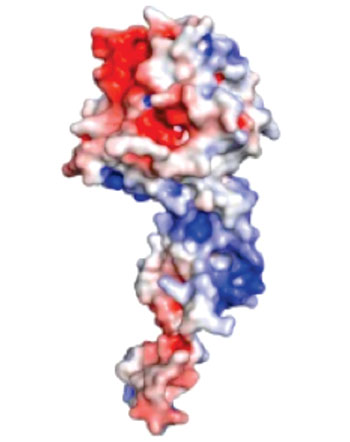Ebolavirus Nucleoprotein Suggested as Possible Drug Target
By LabMedica International staff writers
Posted on 20 Apr 2015
A team of molecular virologists has isolated and characterized a peptide from Ebolavirus (EBOV) that is critical to the pathogen's ability to reproduce inside infected cells.Posted on 20 Apr 2015
Ebola is an RNA virus whose nucleic acid package is covered with a protective nucleoprotein (NP) coat. NP alternates between an RNA-template-bound form and a template-free form to provide the viral polymerase access to the RNA template. In addition, newly synthesized NP must be prevented from indiscriminately binding to nonviral RNAs.

Image: A protein — shown in red, white, and blue — typically coats the genome of the Ebolavirus, providing protection from enzymes that can destroy the virus’s genetic material. This protein coat is removed to allow the virus to replicate its genome in infected cells. Interfering with the removal and the return of the protein coat to the viral genome can kill the Ebola virus, a discovery that opens the door to more effective treatments (Photo courtesy of Washington University School of Medicine).
Investigators at the Washington University School of Medicine (St. Louis, MO, USA) have explained the molecular bases for these critical processes in a paper published in the April 9, 2015, online edition of the journal Cell Reports. They reported the identification of an intrinsically disordered peptide derived from EBOV VP35 nucleoprotein (NPBP, residues 20–48) that bound to NP with high affinity and specificity, inhibited NP oligomerization, and released RNA from NP-RNA complexes in vitro.
X-ray crystallography analysis at a resolution of 3.7 Angstroms revealed that NPBP peptide occluded a large surface area that was important for NP-NP and NP-RNA interactions and for viral RNA synthesis. This peptide represented a highly conserved viral interface that was important for EBOV replication and could be targeted for therapeutic development.
“One of the major challenges was that the part of VP35 involved in this interaction is an intrinsically disordered peptide,” said first author Dr. Daisy Leung, assistant professor of pathology and immunology at Washington University Medical School. “This means that it may not take on a definite structure until it binds to another protein. That made structural studies of VP35 difficult because the structure, which plays a critical role in determining function, does not form without its specific binding partner.”
Related Links:
Washington University School of Medicine













